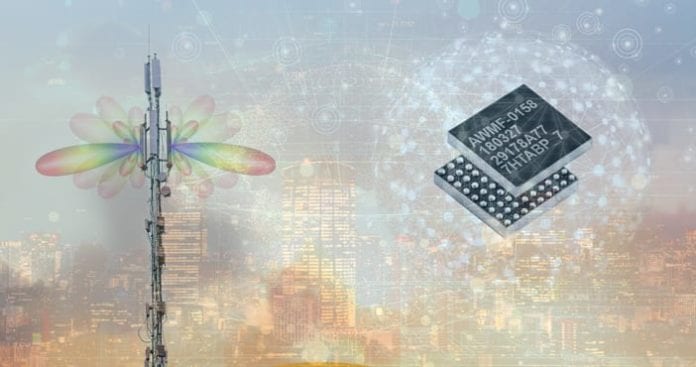5G has arrived. One consequence will be the largest volume of millimeter-wave (mmW) ICs ever produced! A radical use case evolution is happening to make ubiquitous 5G possible by harnessing mmW spectrum to increase data speeds by orders of magnitude.
Verizon launched its fixed wireless access (FWA) service, “5G Home” in four US cities. AT&T recently made the first mobile 5G browsing session on commercial 5G network equipment, and plans to rollout 5G service to 19 cities next year. T-Mobile has also announced multibillion-dollar agreements with OEM manufacturers for deployment in 2019. The network operators in the US are predominantly using high band, millimeter wave frequencies for 5G. As the market leader in mmW silicon ICs for 5G antennas, Anokiwave continues to execute on an aggressive strategy to deliver the technology needed for mmW 5G telecommunication networks with our second generation of 5G ICs supporting 3GPP compliance for 5G-NR now available, and our platform of 3rd generation solutions in advanced development.
We are now beginning the multi-year rollout of 5G NR that should take us to through the next decade. For this market to realize its huge potential, and to develop as promised, OEMs, and RF component suppliers like Anokiwave need to not only address the technical challenges, but also consider the economic factors that will ensure the success of 5G.
One example of where these technical and economic factors overlap is at the active antenna air interface, where the link budget determining the user experience and Quality-of-Service is largely determined. Here, the most important factors determining the performance of active antennas – and consequently the radio link – are the observable sensitivity and radiated power. While transmitting enough signal power is critical, it is also essential that it must be developed efficiently.
Excessive power dissipation not only results in economic consequences from the obvious increase in operating costs, but also to larger size and weight, reduced reliability, and more restrictions in unit deployment, all resulting in increases in the total cost of ownership. A key performance indicator is the antenna consumption factor or the ratio of the EIRP to dissipated DC power of the antenna (both in Watts). Keeping that ratio high is critical in addition to continuing to meet the 3GPP and regulatory standards.
As the industry continues its rapid commercialization of active antennas, there is an intense focus on cost reduction by navigating the traditional volume manufacturing curve, leveraging economies of scale and the elimination of unnecessary, non-value added activities. Anokiwave’s goal is to help customers build the most cost-effective arrays improving the total cost of ownership for the service provider. An important illustration of this principle in practice is the elimination of array calibration using Anokiwave’s ZERO-CAL® technology; removing array alignment and costly unnecessary factory testing while at the same time improving predictability of performance.
A key metric and goal for service Operators is $/data-bit, and the need to continually reduce the network operating expenses (OPEX). Unsurprisingly, this is fundamental to the roll-out of 5G-NR. Anokiwave is working intensely to address the energy requirements of the system. For example, a hypothetical mmW 5G-NR network consisting of 500,000 large gNodeB base stations, and 5 million small cells, is projected to consume over 2.65 TWh of power in its active antennas. The superior integration capability of silicon enables Anokiwave to embed power-saving green functionality into its mmW ICs, resulting in a substantial reduction in operating energy consumption. We believe by using the Anokiwave green functionality the total energy savings could be up to 33%.
As mmW Active Antennas are being industrialized in rapidly increasing volumes, Anokiwave’s silicon ICs are providing significant cost and technical advantages to the system, as well as enabling network OPEX improvements. With low-cost materials, embedded ZERO-CAL® and green features, field health monitors for remote monitoring, as well as the continued drive to higher power efficiency, Anokiwave is leading the way for the economic and technical improvements that ensure the success of 5G. To learn more about Anokiwave’s 5G efforts, please visit www.anokiwave.com/5g.

